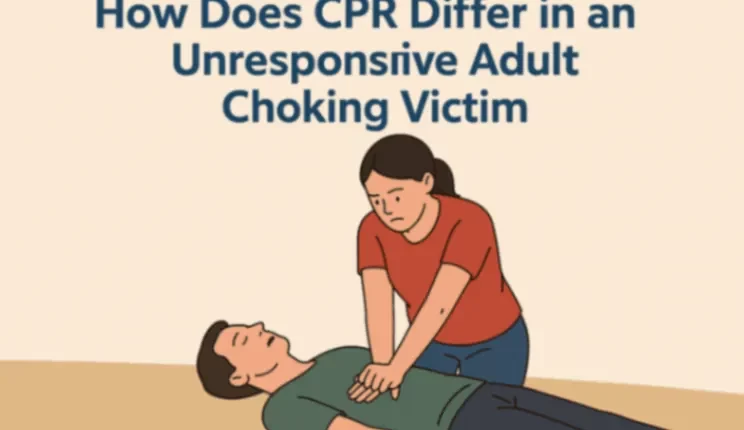Share this @internewscast.com
What would you do if someone suddenly collapsed in front of you—unable to breathe, turning blue, and completely unresponsive?
In critical moments, every second is vital. Standard CPR alone isn’t sufficient. When an adult who’s choking becomes unconscious, it’s crucial to switch gears immediately. This guide outlines the modified approach to CPR for an unresponsive adult choking victim. No unnecessary details—just life-saving steps. It’s designed for anyone who wants to be ready when every moment matters. Let’s begin!
Understanding CPR: The Basics
Typically, adult CPR involves 30 chest compressions followed by 2 rescue breaths, maintaining this 30:2 cycle until professional help arrives or the individual responds. However, when choking is involved and the victim becomes unresponsive, the procedure requires adjustments.
Before diving into those differences, let’s recap standard CPR:
-
30 chest compressions at a rate of 100–120/min
-
2 rescue breaths if the airway is clear
-
Continue until help comes
This method helps maintain circulation and oxygen flow. But what if the airway is blocked and air can’t get in? That’s where modified CPR comes in.
What Happens When an Adult Chokes—and Why Time Is Critical
Choking occurs when food or an object obstructs the airway, halting airflow. A conscious individual may appear panicked, grasp their throat, or attempt to cough. If the obstruction isn’t cleared, oxygen levels drop, leading to collapse. Once they lose consciousness, the body ceases coughing. This is when CPR protocols for an unresponsive adult choking victim come into play.
Older adults are especially at risk. Weak muscles, dental problems, or medical issues like Parkinson’s make swallowing harder. It’s not just about age, it’s also about health and timing.
Quick Summary: Key Differences in Choking-Related CPR
| CPR Element | Standard Adult CPR | Unresponsive Choking Victim |
|---|---|---|
| Airway | Clear | Blocked |
| Rescue Breaths | Yes (after compressions) | Only if chest rises |
| Chest Compressions | Start immediately | Start immediately |
| Finger Sweep | Not needed | Only if object is visible |
| Abdominal Thrusts | Yes (if conscious) | No |
| Primary Goal | Circulation + breathing | Dislodge object + circulation |
This table offers a quick visual to help you instantly remember what changes in an emergency.
CPR vs. Choking Response: What Changes When They Collapse?
When someone is choking but still awake, abdominal thrusts (Heimlich maneuver) are the go-to method. You press above the navel, push inward and upward, trying to force the object out.
But when they fall unconscious, you switch gears. You don’t start with breaths. You don’t do thrusts standing up. Here’s how CPR for unresponsive choking adult victims differs from regular CPR:
|
Situation |
Standard Adult CPR |
Unresponsive Choking CPR |
|
Is the airway clear? |
Yes |
No |
|
Rescue breaths start immediately? |
Yes |
Only if airway is clear |
|
Chest compressions first? |
Yes |
Yes |
|
Finger sweep needed? |
Not required |
Yes, if object is visible |
|
Breath effectiveness |
Usually effective |
Often ineffective if blocked |
|
Compression priority |
Equal with breaths |
Compression-first approach |
This modified CPR for choking adult victims focuses heavily on chest compressions.
Step-by-Step CPR for an Unconscious Choking Adult
You witness someone collapse while eating. They’re not breathing. No response when you shout. You suspect choking. Here’s how to perform CPR on a choking adult who is unresponsive:
-
Call 911 immediately – Or ask someone else to do it. Time is oxygen.
-
Check for Breathing and Pulse – Look, listen, and feel. If none, start CPR.
-
Open Mouth & Look Inside – Can you see the object? If yes, try to remove it carefully. Use a sweeping motion only if it’s clearly visible.
-
Begin Chest Compressions – Do 30 compressions hard and fast, center of the chest.
-
Open Airway & Try Breaths – Tilt head slightly, lift chin. Give 2 slow breaths.
-
If Chest Doesn’t Rise? – Suspect blockage. Resume compressions immediately.
-
Repeat the Cycle – 30:2 pattern. Keep checking the mouth for visible obstructions.
This is a modified CPR for choking adults where the object may move with compressions. Each round increases the chance of clearing the airway.
How This Differs From Standard Adult CPR
Here’s where people get confused. In regular CPR, breaths are key. In unresponsive choking, the airway is blocked, so breaths won’t help.
-
Never perform a blind finger sweep. It could push the object deeper into the airway. Only remove the object if it’s clearly visible and within reach.
-
You don’t stop chest compressions unless someone else is there to assist.
-
You emphasize compressions more than breaths. Rescue breaths won’t pass through a blocked throat.
Differences in CPR techniques mean your main goal is to move the object with chest pressure.
And remember: standard adult CPR guidelines (30:2) still apply once an advanced airway is placed by responders.
Common Mistakes to Avoid
Even trained responders mess this up. Some errors are more common than people realize. Knowing them ahead of time can reduce panic and save time.
-
Giving rescue breaths before checking the airway
-
Performing blind finger sweeps (can push the object deeper into the throat)
-
Stopping compressions too often to reassess
-
Waiting too long to start CPR
-
Panicking and rushing through compressions
Some extra problems people run into:
-
Trying to sit the person up – Always keep them flat on their back once they’re unresponsive.
-
Doing abdominal thrusts on the ground – Not safe or helpful when unconscious.
-
Check for a pulse for too long. If you’re unsure, begin compressions.
-
Using uneven pressure while compressing leads to poor blood flow.
Always keep your hands centered on your chest. Push hard and fast. Let the chest rise fully between compressions. Every mistake you avoid makes a real difference.
When to Stop CPR or Modify Response
There are certain points where you stop or switch the method:
-
The person starts to breathe on their own – Roll them gently onto their side. Keep their airway clear and watch for normal breathing.
-
You become too tired to continue – If you’re alone and can’t go on, get help right away.
-
Emergency services take over – Always give them space to work, but share what you did.
-
You spot and remove the object – If you can clearly see and remove the blockage, do that carefully. Then switch to the usual CPR rhythm of 30 compressions and 2 breaths.
Don’t stop unless one of the above happens. If nothing changes, keep going with the CPR steps for an unconscious choking victim. These few moments matter most.
-
If you’re unsure whether the object is still there, always treat it like it is.
-
Never do a blind finger sweep. You might push the object deeper.
-
Stay calm. Breathe when you can. Keep compressions steady.
Remember: C.L.O.C.K.
Use this quick memory aid to stay focused:
-
C – Call 911
-
L – Look inside the mouth
-
O – Only remove visible objects
-
C – Compressions first
-
K – Keep going until help arrives
Every second counts. Your effort may give them another chance.
Final Thoughts: Be Prepared
CPR isn’t just for medical pros. Anyone can do it. When every second matters, knowing how CPR differs in an unresponsive adult choking victim can give them a second chance at life. Learn it. Practice it. You might be the reason someone survives.
Want to learn more? Take a certified CPR or BLS training near you—or check online platforms like the Red Cross or American Heart Association to get started. Taking BLS or CPR classes helps you handle the unexpected. You’ll practice unresponsive adult choking CPR steps until they become second nature.
Lives depend on what you do in those few minutes. Make sure you’re ready.
Related: How Can You Achieve a High Chest Compression Fraction?
Frequently Asked Questions
How long should I perform CPR on an unresponsive choking victim?
Keep going until EMS arrives, you see visible improvement, or you’re physically unable to continue. There’s no fixed time, only that stopping too early can mean death.
Should I try back blows on an unconscious adult?
No. Back blows are for conscious victims. When they collapse, stick with chest compressions and airway checks.
Can abdominal thrusts be done if the person is lying down?
They’re not advised in that position. Instead, chest compressions serve the same purpose and are safer when someone is unconscious.
What if the object comes loose but the person doesn’t wake up?
Switch to standard CPR with breaths. Their brain may still need oxygen support until they regain consciousness.
Is CPR certification needed to help in public?
Not legally. Good Samaritan laws protect you. But certification boosts confidence and skill, especially with differences in CPR techniques.













